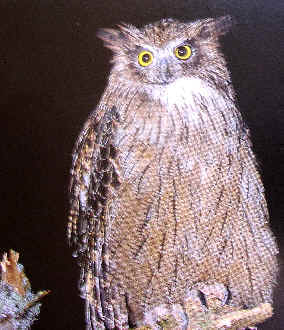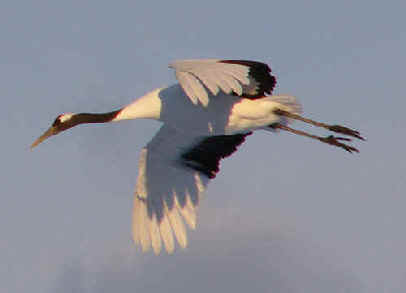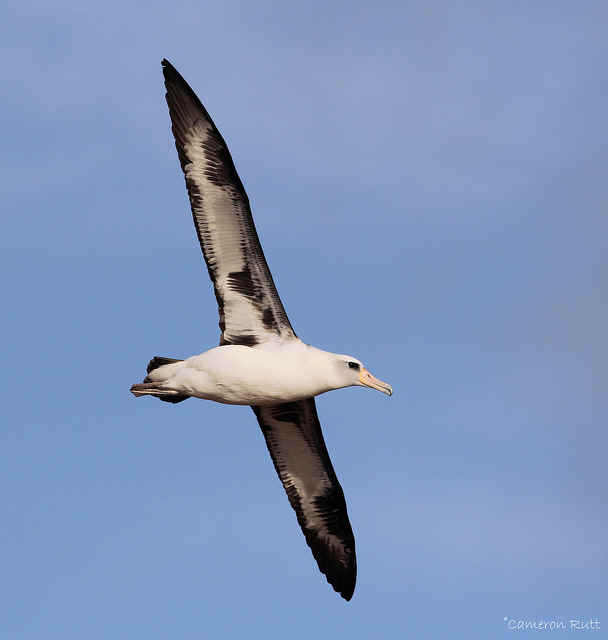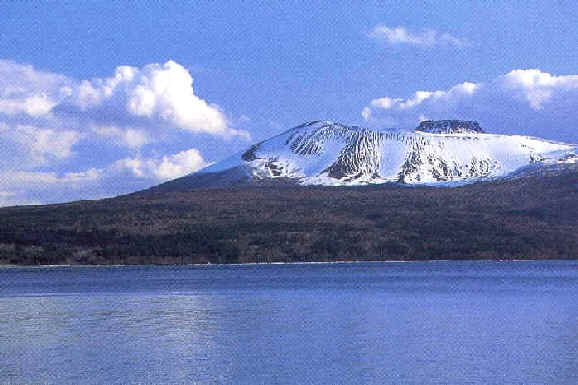
E-mail: font@focusonnature.com
Phone: Toll-free in USA 1-888-721-3555
or 302/529-1876
 |
PO
Box 9021, Wilmington, DE 19809, USA E-mail: font@focusonnature.com Phone: Toll-free in USA 1-888-721-3555 or 302/529-1876 |

A Focus On Nature
Tour
in
Japan
in the Fall
on the Islands of
Honshu
& Hokkaido
(mostly Hokkaido)
With White-tailed
Eagles,
and Red-crowned (or Japanese) Cranes,
And our quest for the massive, rare
Blakiston's Fish Owl.
(During all of our previous tours
in Hokkaido,
we've found it.)
(tour: FON/JA-3' 16)
October xx - November x, 2016
FONT
has been doing Japan birding tours for two decades.
This to be our 39th birding & nature tour in Japan!
Links:
A List & Photo Gallery of Japan Birds, in 2 Parts
Rare Birds during FONT Japan Tours
Some Highlights of Our Past Tours in Japan
A magnificent sight to
be enjoyed during this tour are dancing Red-crowned, or Japanese Cranes in the
snow. Only in Japan in Hokkaido, and there only locally.
At one time, back in
1924, there was just a very small population of this species - less than 20.
From that brink of extinction, the number has increased to over 1200 birds in
Hokkaido, during recent years.
Seeing these cranes, or "tanchos"
as they are known in Japanese, is one of the most wonderful of birding
experiences, not
just in Japan, but anywhere.

Tue Oct 20: Arrival at Narita-Tokyo Int'l. Airport (about 2 hours north of Tokyo). Transfer to overnight in the area of Narita (at a western-style hotel).
Wed Oct
21: Travel from Narita to the area of
Karuizawa (in the mountains of Honshu
about 2 hours north of Tokyo), with a shorebirding stop along the way. The first
of 2 overnights in the Karuizawa area.
Thu Oct 22: A full-day of birding in the picturesque Karuizawa area, for birds
such as the Copper Pheasant and the Green Pheasant, both endemic to Japan, the
Japanese Green Woodpecker, also endemic, the Azure-winged Magpie, Japanese
Grosbeak, and
possibly the Japanese Waxwing and Solitary Snipe, along with, for sure, an
assortment of buntings and finches, and among waterfowl both Smew and
Mandarin
Duck.
Another duck that is possible is the Baikal Teal, a species that has been
declining.
In the non-bird realm, we should also see the Japanese Macaque, also
known as the "Snow Monkey".
Fri Oct 23: More birding, most of this day, in Honshu, in the mountains, and in
open country and a river valley for a continued assortment of birds.
In the evening
we'll board an overnight ferry
(a large vessel) to go from Honshu to Hokkaido.

Laysan Albatross in flight
(photo courtesy of Cameron Rutt)
Sat Oct
24: Pelagic birding onboard the ferry, for albatrosses,
shearwaters, alcids, and other oceanic birds. It will be a full-day
at sea as we travel north. During this trip in the past, we've seen a number of
pelagic birds, with sometimes hundreds of Laysan Albatross.
We've also been lucky to see on a couple occasions, from the ferry, the rare
Short-tailed Albatross.
Sometimes in the fall and winter we've seen numerous and various alcids
including both murres, Ancient Murrelet, Long-billed Murrelet, and
the small Least Auklet.
During one ferry trip, we saw an estimated 25,000 Crested Auklets.
During one of our offshore trips on this ferry, a Gyrfalcon flew by the
boat, and circled above us before heading toward the coast. Another time, a Short-eared
Owl flew by us as we were offshore.
In the evening, we'll arrive at Tomakomai, in
Hokkaido. Overnight there.
Sun Oct
25: Our first Hokkaido birding will be in the area of the Shikotsu-Toya
National Park, with a visit to the nearby nature center by the Lake
Utonai-ko. Overnight at a hotel in the Shikotsu National Park.
In this area, during our previous tours, birds have included: Siberian
Nuthatch (a new species, split from the Eurasian Nuthatch), the "Brandt's
Jay" (a distinctive, vividly-colored form of the Eurasian Jay -
it may be split), as well as both White-backed and Black Woodpeckers,
Gray-headed Woodpecker, Varied Tit, Japanese Accentor, Eurasian
Bullfinch (2 forms) and various other finches and buntings.
Also in this area, we've seen, during past tours, the recently-split Oriental
Magpie, that has recently established itself in the
area.
Mon Oct
26: This day we'll travel east, with some birding in central Hokkaido
in the Daisetsuzan
National Park. With high mountains, the area is called the "roof of
Hokkaido". (When we've been here before we've gone up in as cable car,
and had some good birding in the mountain forest.) Overnight at Daisetsuzan.

The Pine Grosbeak is one of
the birds
in the highlands of Hokkaido.
Tue Oct 27: Travel north to the areas of Sarobetsu & Kucharo-ko, near the northern tip of Hokkaido. This is one of the best regions in the fall for migrants, with a variety of habitats. During 2 days, we'll have ample time for finding many birds & enjoying the area. Among the many birds should be our first sea-eagles, and other raptors. Overnight in Toyotomi.
Wed Oct 28: Some morning birding in the areas of Sarobetshu & Kucharo-ko. We'll go further north to Wakkanai. From there, we'll take a ferry-ride to the offshore Island of Rishiri. That island can be with good birds (notably migrants), and the boat-rides can be good for seabirds, especially alcids, such as the Spectacled Guillemot. Overnight in Wakkanai.
Thu Oct
29: Travel south along the northeast coast of Hokkaido, to Abashiri,
with birding along the way.
The coastal birding should be excellent with White-tailed Eagles, other raptors, and various species of gulls, waterbirds,
and landbirds.
The waterbirds would include an assortment of ducks, maybe some geese,
certainly swans, and also loons (or divers), grebes,
and probably more alcids. Overnight in Abashiri.
Fri Oct
30: This morning we'll visit the wild Shiretoko
Peninsula (where there's a national park with the same name),
and the small fishing town of Rausu where birding can be quite good.
In the afternoon, we'll head to the Akan
National Park.
Overnight will be in the town of Kawayu
in the national park. (In the town, there are shops with some wonderful
wood-carvings of birds, such as the Blakiston's Fish Owl by the
Ainu people).
Near Kawayu in the past, at the end of the day, we've found both the Ural
Owl and the Japanese Scops Owl.

A volcano, forest, & large
lake in the Akan National Park
Sat Oct
31: In the pm this day, after seeing yet more "new
birds" for us, we see one that should be on the highlights of the
tour, the Red-crowned, or Japanese, Crane.
Overnight again in Kawayu, a town also known for
its hot springs & baths.
Sun Nov
1: There may be more cranes, this day, and other birds
too, such as the Hazel Grouse, in southeastern Hokkaido, but our main
objective of the day will be as it is getting dark when we should see the real Blakiston's
Fish Owl (not just a wood carving). It is one of the biggest
and rarest owls in the world. We have seen it in this area during every tour
we've done in the past.
If we don't see it this day (for some unforeseen reason, weather or whatever),
we'll also allocate the following evening for it. As noted, this spectacular
species has been seen during over 20 FONT tours in almost that many
years, but it is good to have a second evening as a back-up just in case.
Overnight in Nemuro, in far-eastern
Hokkaido, near, in fact, the easternmost point in all of Japan.
Mon Nov 2: There will be some fine birding
this day in the area of Nemuro, as we do nearly our final birding of the tour on
a picturesque peninsula, with a coastline that can be filled with birds. Among
them, there may be some rarities for Japan, including the Steller's Eider,
Rock Sandpiper, Red-faced Cormorant, and Yellow-billed Loon,
but there certainly will be birds to be enjoyed, and almost always for us there
has been something unexpected.
Landbirds in the area can include the Asian Rosy Finch, other finches
and buntings, including sometimes Snow Buntings and Lapland
Buntings (also called, of course, Lapland Longspurs).
After our second go-at-it for the Blakiston's Fish Owl, if needed, we'll
go a couple hours west to Kushiro, where
we'll spend the night.
Tue Nov
3: From Kushiro, this day,
we go further west in Hokkaido, with birding along the way, to the airport for
our flight to Tokyo. We'll spend this, our last night in Japan, back in the area
of the international airport at Narita.
Wed Nov 4: Those, whose international
flights for home depart in the afternoon, would go this morning to a fishing
port, where birds can abound. In the past there, we've seen as many as 9
species of gulls, shearwaters from shore, and once a rare Black-faced
Spoonbill.
We'll certainly see something of note there this morning, before our departure from Japan, from the Narita International Airport.
Note:
![]()
Prices:
US$ 3,795 - per person (from Narita-Tokyo airport), based upon double-occupancy
Single-supplement: $395.
(Single occupancy may not be available for
the one night onboard the ferry from Honshu to Hokkaido.)
Includes:
All
overnight accommodations. (Most to be in "western-style" hotels.)
Meals (except those on Oct. 20 & after breakfast on Nov. 4).
(Most meals
can be "western" or "Japanese" as participants desire.)
All
ground transportation in Japan.
Services of FONT birding leader and local guides.
Does not include:
Drinks and other items of a personal nature.
Air transportation (to/from & within Japan).
"Focus on Nature
Tours" can arrange economical fares for the flights to/from Japan.
Please contact us regarding the best fares possible.
The leader for this
tour will be Armas Hill, who has birded in Japan
numerous times since 1984.
A deposit of US $500 is required to register for this tour.